Answered step by step
Verified Expert Solution
Question
1 Approved Answer
Specific Requirements Case Study: Assessing Attitudes Towards Climate Change and Renewable Energy in Australia Synopsis: Climate change and renewable energy are critical issues facing
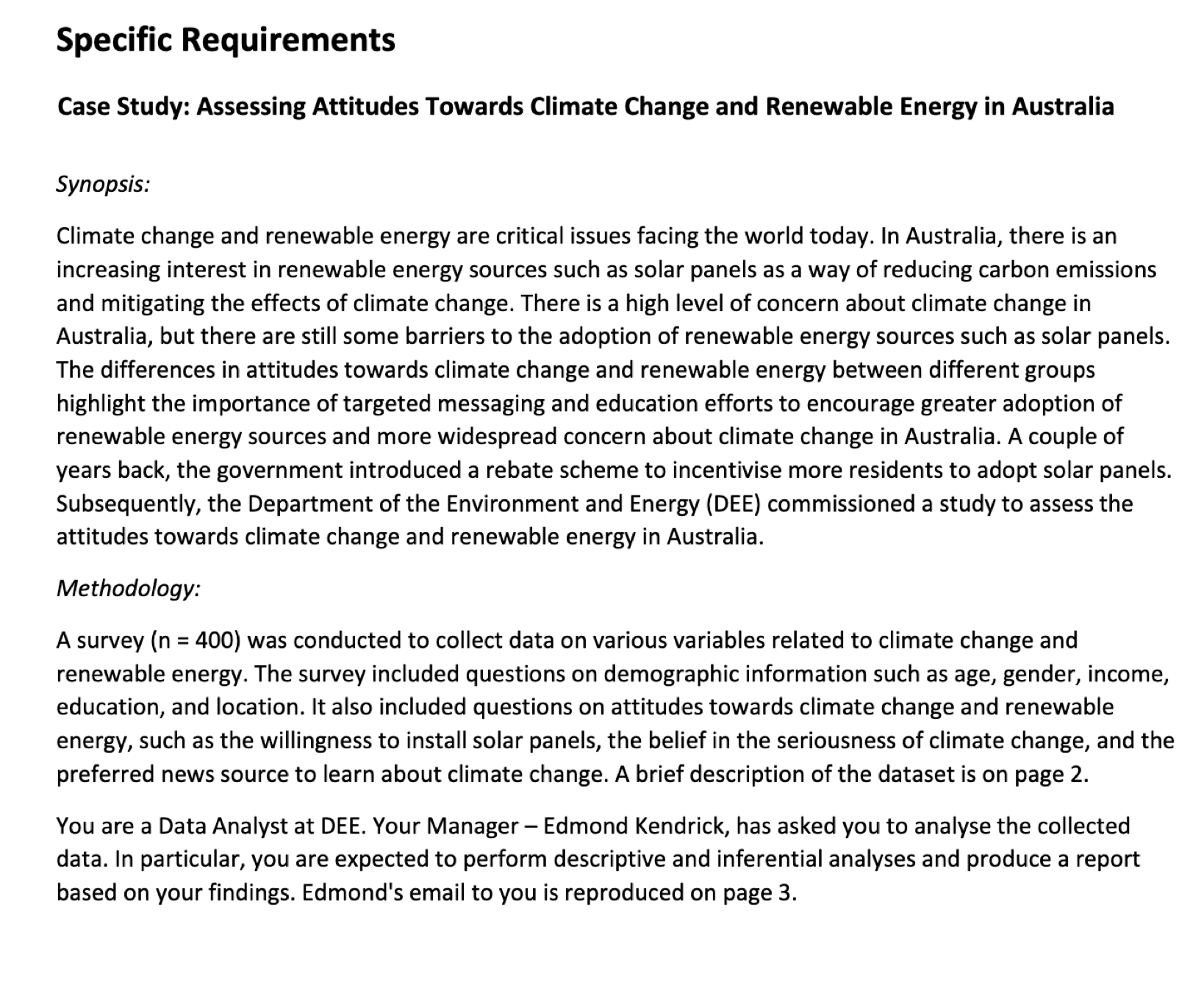
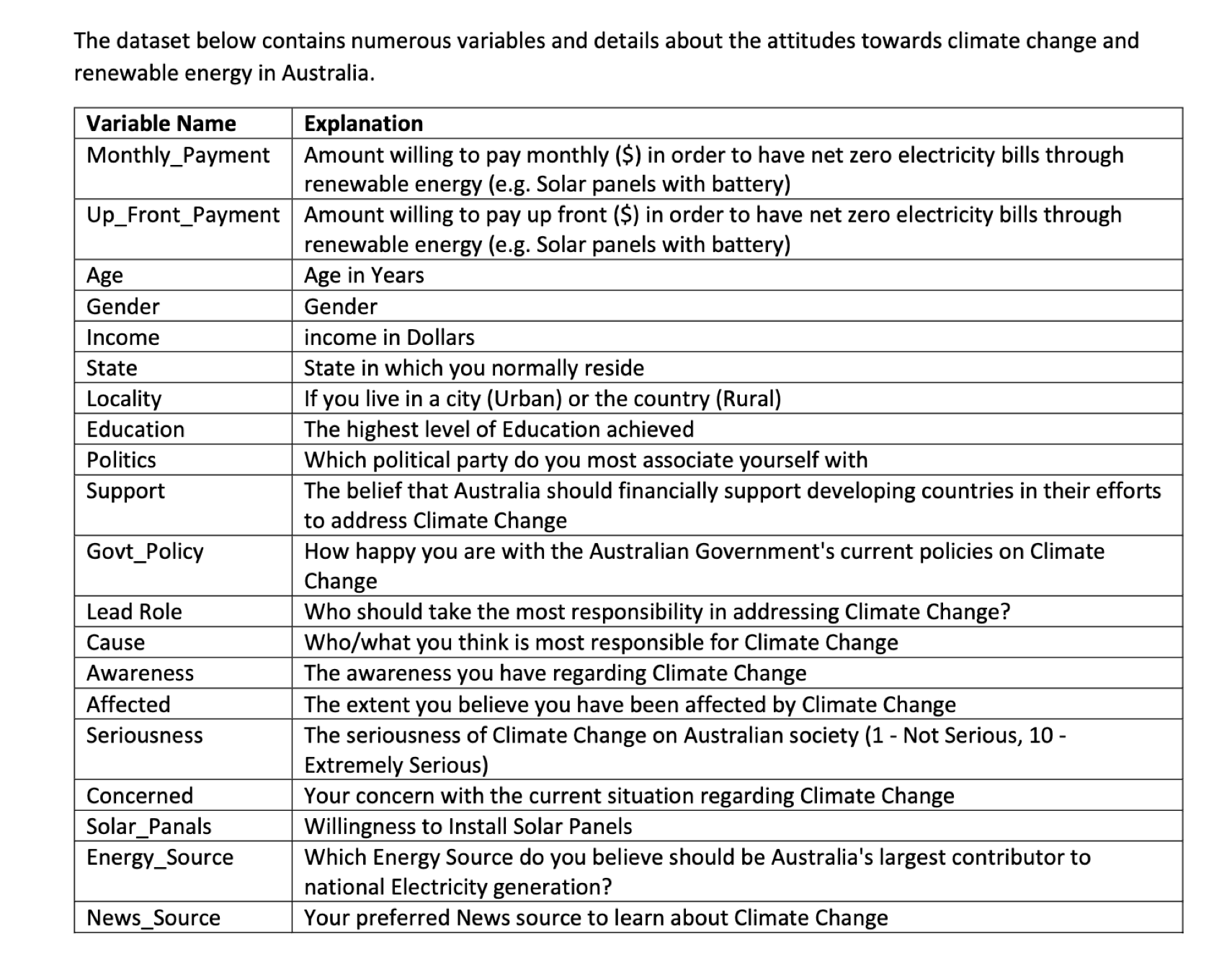
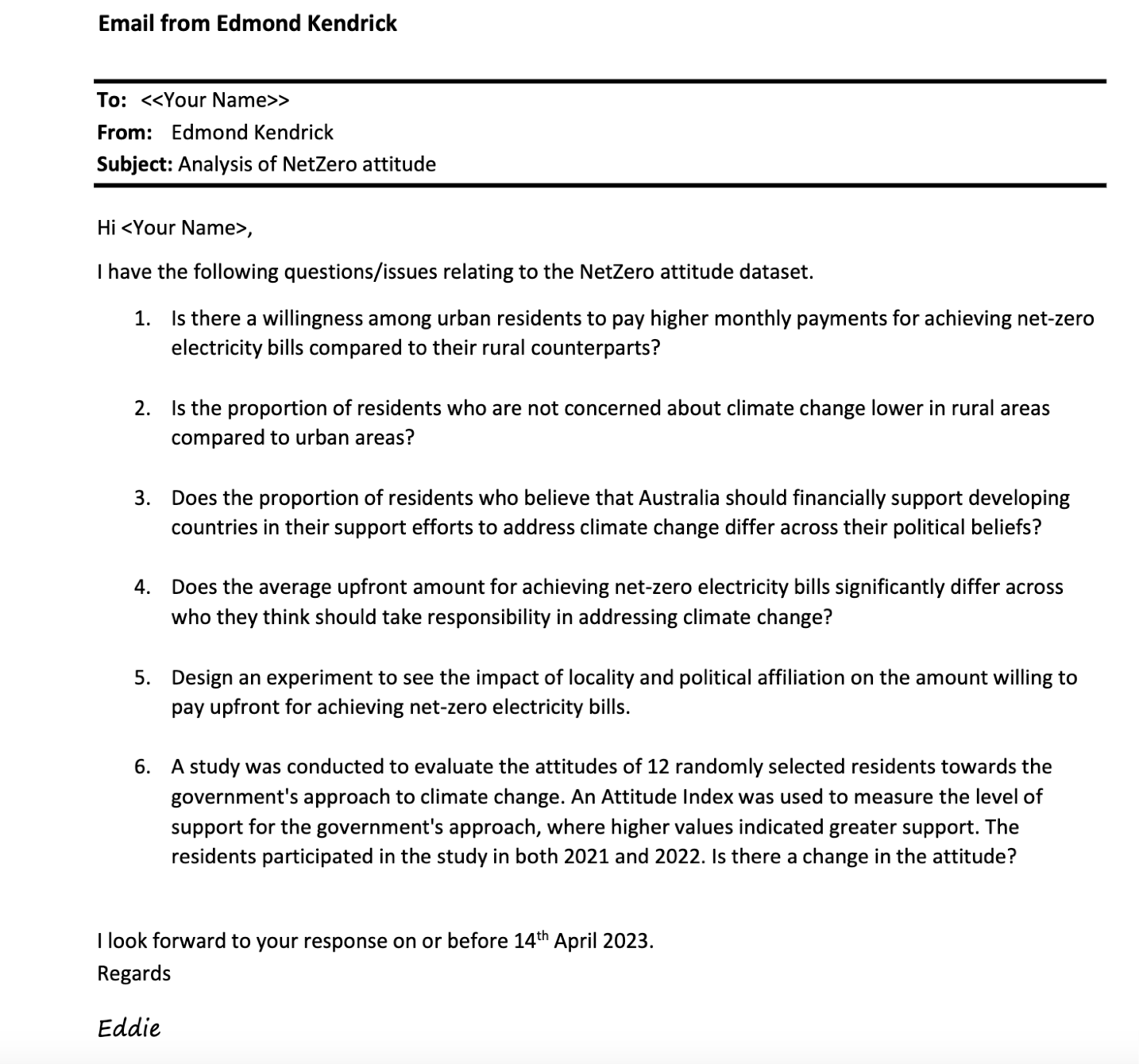
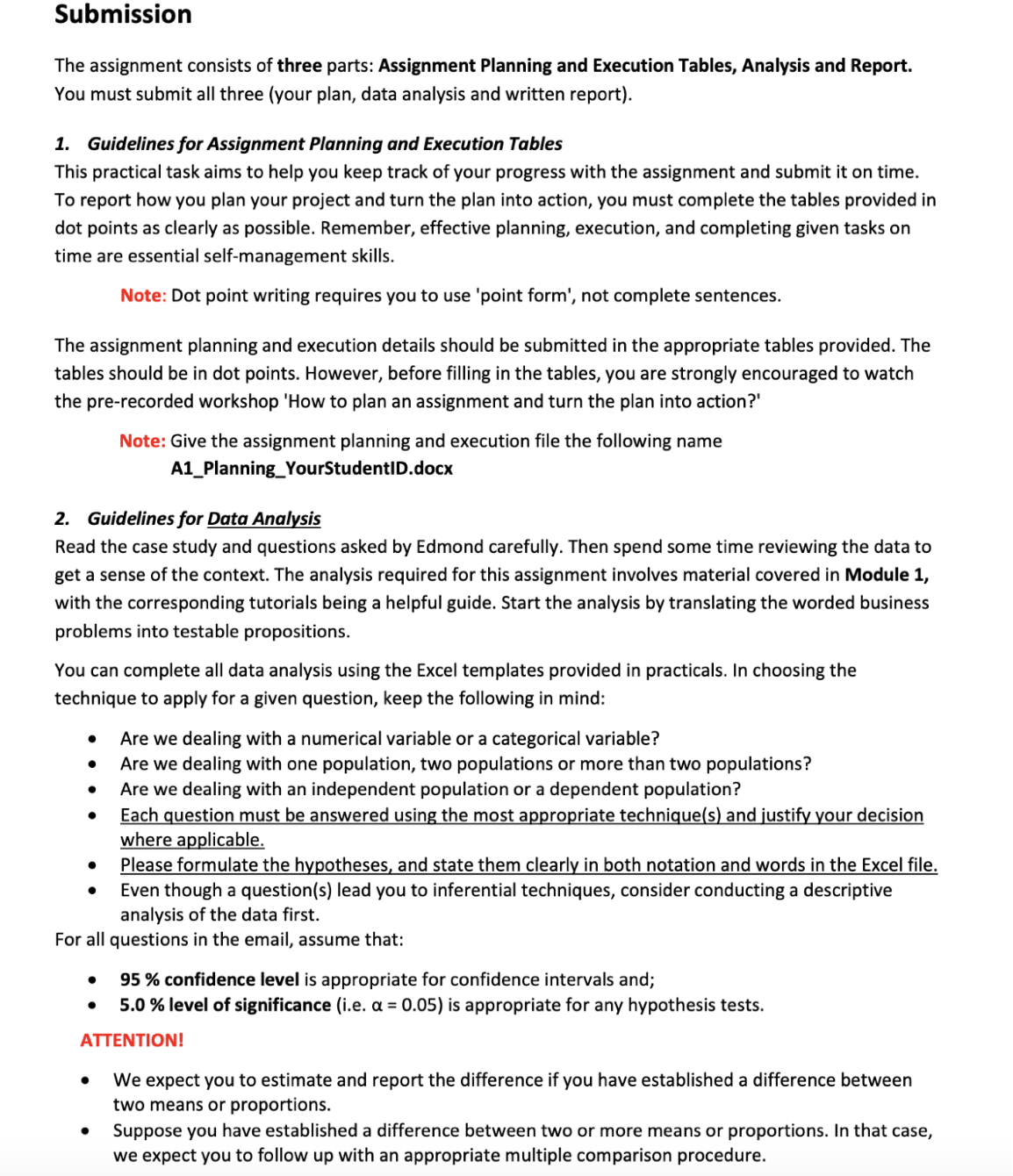
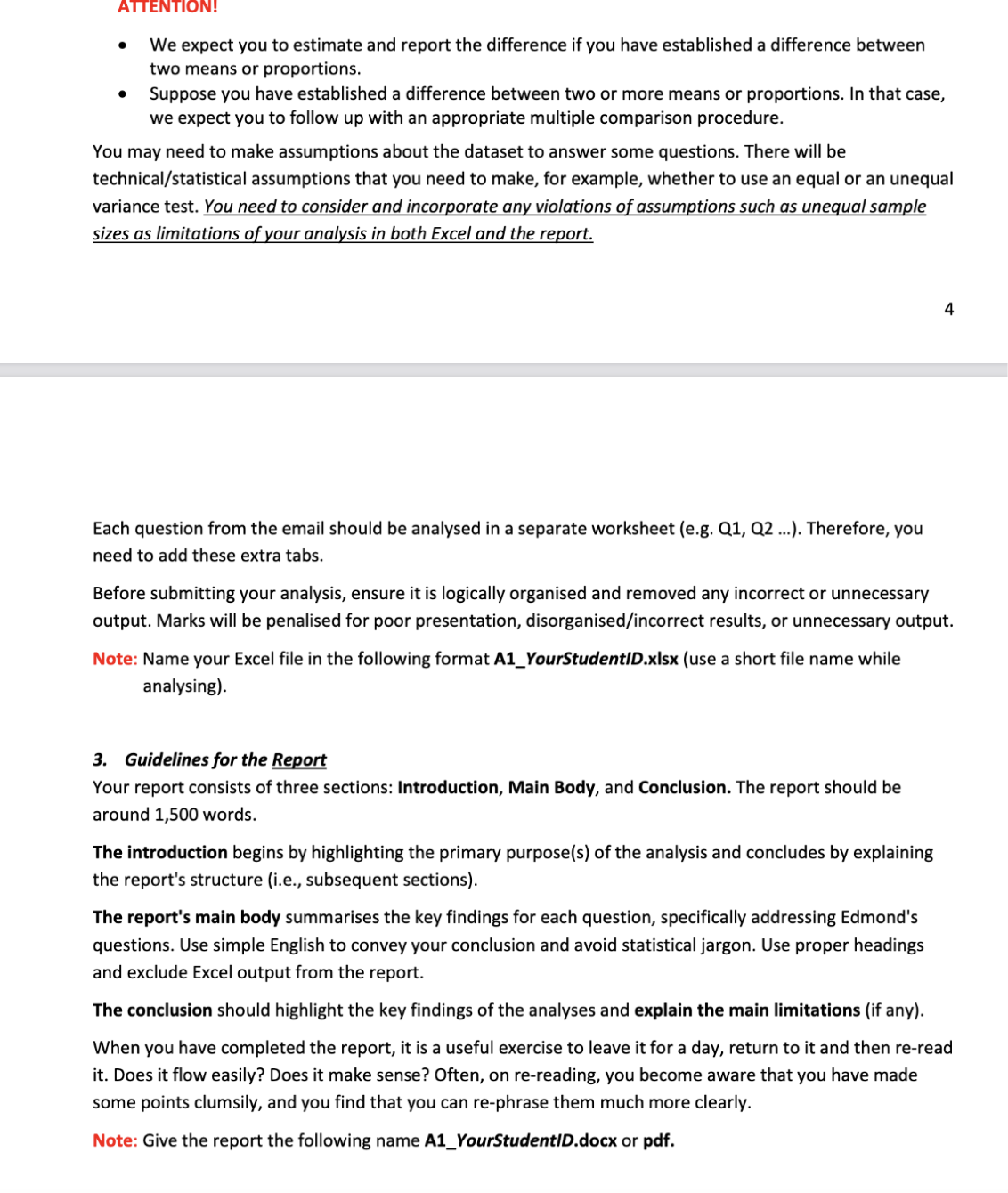
Specific Requirements Case Study: Assessing Attitudes Towards Climate Change and Renewable Energy in Australia Synopsis: Climate change and renewable energy are critical issues facing the world today. In Australia, there is an increasing interest in renewable energy sources such as solar panels as a way of reducing carbon emissions and mitigating the effects of climate change. There is a high level of concern about climate change in Australia, but there are still some barriers to the adoption of renewable energy sources such as solar panels. The differences in attitudes towards climate change and renewable energy between different groups highlight the importance of targeted messaging and education efforts to encourage greater adoption of renewable energy sources and more widespread concern about climate change in Australia. A couple of years back, the government introduced a rebate scheme to incentivise more residents to adopt solar panels. Subsequently, the Department of the Environment and Energy (DEE) commissioned a study to assess the attitudes towards climate change and renewable energy in Australia. Methodology: A survey (n = 400) was conducted to collect data on various variables related to climate change and renewable energy. The survey included questions on demographic information such as age, gender, income, education, and location. It also included questions on attitudes towards climate change and renewable energy, such as the willingness to install solar panels, the belief in the seriousness of climate change, and the preferred news source to learn about climate change. A brief description of the dataset is on page 2. You are a Data Analyst at DEE. Your Manager - Edmond Kendrick, has asked you to analyse the collected data. In particular, you are expected to perform descriptive and inferential analyses and produce a report based on your findings. Edmond's email to you is reproduced on page 3. The dataset below contains numerous variables and details about the attitudes towards climate change and renewable energy in Australia. Variable Name Monthly Payment Explanation Amount willing to pay monthly ($) in order to have net zero electricity bills through renewable energy (e.g. Solar panels with battery) Up_Front_Payment Amount willing to pay up front ($) in order to have net zero electricity bills through renewable energy (e.g. Solar panels with battery) Age Gender Income State Locality Education Politics Support Govt_Policy Lead Role Cause Awareness Affected Seriousness Concerned Solar_Panals Energy_Source News_Source Age in Years Gender income in Dollars State in which you normally reside If you live in a city (Urban) or the country (Rural) The highest level of Education achieved Which political party do you most associate yourself with The belief that Australia should financially support developing countries in their efforts to address Climate Change How happy you are with the Australian Government's current policies on Climate Change Who should take the most responsibility in addressing Climate Change? Who/what you think is most responsible for Climate Change The awareness you have regarding Climate Change The extent you believe you have been affected by Climate Change The seriousness of Climate Change on Australian society (1 - Not Serious, 10 - Extremely Serious) Your concern with the current situation regarding Climate Change Willingness to Install Solar Panels Which Energy Source do you believe should be Australia's largest contributor to national Electricity generation? Your preferred News source to learn about Climate Change Email from Edmond Kendrick To: < > From: Edmond Kendrick Subject: Analysis of NetZero attitude Hi , I have the following questions/issues relating to the NetZero attitude dataset. 1. Is there a willingness among urban residents to pay higher monthly payments for achieving net-zero electricity bills compared to their rural counterparts? 2. Is the proportion of residents who are not concerned about climate change lower in rural areas compared to urban areas? 3. Does the proportion of residents who believe that Australia should financially support developing countries in their support efforts to address climate change differ across their political beliefs? 4. Does the average upfront amount for achieving net-zero electricity bills significantly differ across who they think should take responsibility in addressing climate change? 5. Design an experiment to see the impact of locality and political affiliation on the amount willing to pay upfront for achieving net-zero electricity bills. 6. A study was conducted to evaluate the attitudes of 12 randomly selected residents towards the government's approach to climate change. An Attitude Index was used to measure the level of support for the government's approach, where higher values indicated greater support. The residents participated in the study in both 2021 and 2022. Is there a change in the attitude? I look forward to your response on or before 14th April 2023. Regards Eddie Submission The assignment consists of three parts: Assignment Planning and Execution Tables, Analysis and Report. You must submit all three (your plan, data analysis and written report). 1. Guidelines for Assignment Planning and Execution Tables This practical task aims to help you keep track of your progress with the assignment and submit it on time. To report how you plan your project and turn the plan into action, you must complete the tables provided in dot points as clearly as possible. Remember, effective planning, execution, and completing given tasks on time are essential self-management skills. Note: Dot point writing requires you to use 'point form', not complete sentences. The assignment planning and execution details should be submitted in the appropriate tables provided. The tables should be in dot points. However, before filling in the tables, you are strongly encouraged to watch the pre-recorded workshop 'How to plan an assignment and turn the plan into action?' Note: Give the assignment planning and execution file the following name A1_Planning YourStudentID.docx 2. Guidelines for Data Analysis Read the case study and questions asked by Edmond carefully. Then spend some time reviewing the data to get a sense of the context. The analysis required for this assignment involves material covered in Module 1, with the corresponding tutorials being a helpful guide. Start the analysis by translating the worded business problems into testable propositions. You can complete all data analysis using the Excel templates provided in practicals. In choosing the technique to apply for a given question, keep the following in mind: Are we dealing with a numerical variable or a categorical variable? Are we dealing with one population, two populations or more than two populations? Are we dealing with an independent population or a dependent population? Each question must be answered using the most appropriate technique(s) and justify your decision where applicable. Please formulate the hypotheses, and state them clearly in both notation and words in the Excel file. Even though a question(s) lead you to inferential techniques, consider conducting a descriptive analysis of the data first. For all questions in the email, assume that: 95% confidence level is appropriate for confidence intervals and; 5.0% level of significance (i.e. = 0.05) is appropriate for any hypothesis tests. ATTENTION! We expect you to estimate and report the difference if you have established a difference between two means or proportions. Suppose you have established a difference between two or more means or proportions. In that case, we expect you to follow up with an appropriate multiple comparison procedure. ATTENTION! We expect you to estimate and report the difference if you have established a difference between two means or proportions. Suppose you have established a difference between two or more means or proportions. In that case, we expect you to follow up with an appropriate multiple comparison procedure. You may need to make assumptions about the dataset to answer some questions. There will be technical/statistical assumptions that you need to make, for example, whether to use an equal or an unequal variance test. You need to consider and incorporate any violations of assumptions such as unequal sample sizes as limitations of your analysis in both Excel and the report. 4 Each question from the email should be analysed in a separate worksheet (e.g. Q1, Q2 ...). Therefore, you need to add these extra tabs. Before submitting your analysis, ensure it is logically organised and removed any incorrect or unnecessary output. Marks will be penalised for poor presentation, disorganised/incorrect results, or unnecessary output. Note: Name your Excel file in the following format A1_YourStudentID.xlsx (use a short file name while analysing). 3. Guidelines for the Report Your report consists of three sections: Introduction, Main Body, and Conclusion. The report should be around 1,500 words. The introduction begins by highlighting the primary purpose(s) of the analysis and concludes by explaining the report's structure (i.e., subsequent sections). The report's main body summarises the key findings for each question, specifically addressing Edmond's questions. Use simple English to convey your conclusion and avoid statistical jargon. Use proper headings and exclude Excel output from the report. The conclusion should highlight the key findings of the analyses and explain the main limitations (if any). When you have completed the report, it is a useful exercise to leave it for a day, return to it and then re-read it. Does it flow easily? Does it make sense? Often, on re-reading, you become aware that you have made some points clumsily, and you find that you can re-phrase them much more clearly. Note: Give the report the following name A1_YourStudentID.docx or pdf.
Step by Step Solution
There are 3 Steps involved in it
Step: 1
Although the adoption and use of renewable energy sources in Australia is still relatively e...
Get Instant Access to Expert-Tailored Solutions
See step-by-step solutions with expert insights and AI powered tools for academic success
Step: 2

Step: 3

Ace Your Homework with AI
Get the answers you need in no time with our AI-driven, step-by-step assistance
Get Started


